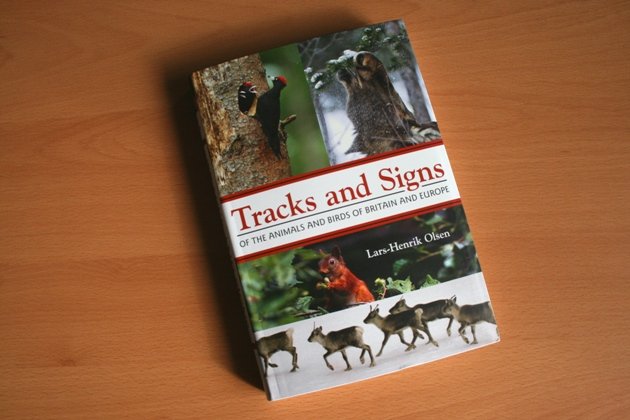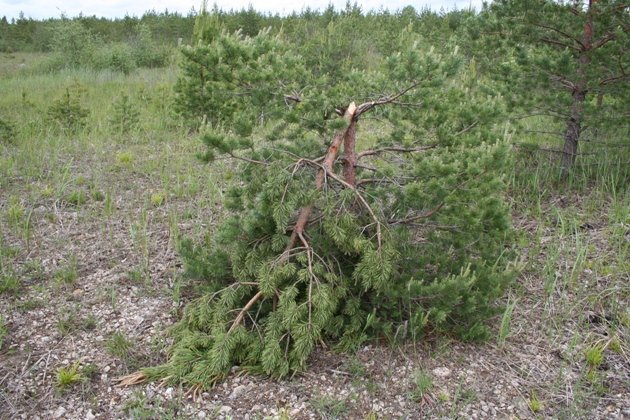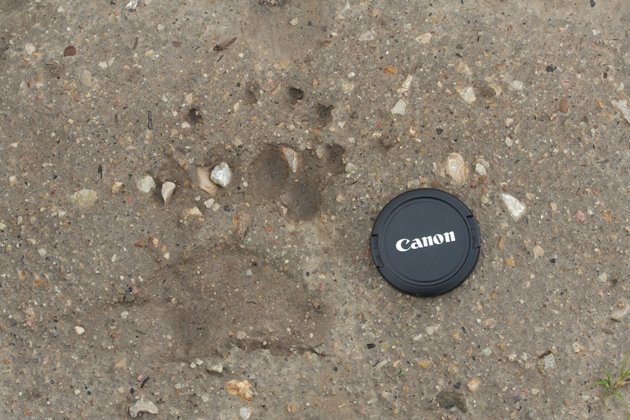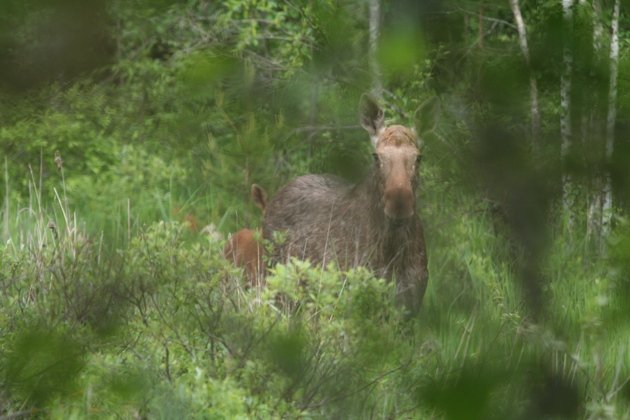
I am a birder, and I love birds. I don’t mind that they share the world with other creatures, and I have even developed an appreciation for mammals, reptiles and amphibians – but only so long as watching them doesn’t collide with my finding birds. I never cared much for insects and my interest in plants never got beyond the veggy section of my supermarked – in spite of buying field guides and giving both groups a good try. When I am out and about, the birds’ reign is only jeopardized by one thing: favourable conditions for tracking!
I have wondered about this, and I think I might have found an explanation. One of the main reasons why I find birding so attractive is not really the birds themselves, it is the process. Birding is an exercise of situational awareness, an intellectual challenge. It requires an alert state of mind, an analysis of the landscape and its elements. One needs to be focussed in order to extract all the useful bits of information from a fleeting glimpse, and one needs to combine all these pieces correctly to reach a substantiated interpretation. It is this analyzing character, the reading of signs, the combining of hints to achieve a look at the picture in its entirety, that birding shares with tracking. It is equally challenging, equally rewarding, and with equal potential for passion and addiction. However, it is not equal in the amount and quality of books that are available on the topic. For Europe, only very few books exist that cover the topic at all. There are several books on feathers that also include some footprints of birds, maybe owl pellets. Track of mammals are usually only used to decorate the otherwise blank insides of a field guide’s covers, and other signs are often not mentioned at all. This is very bad news for a group that is largely nocturnal and has adapted to a secretive lifestyle, and is thus best detected by its tracks and signs.
The announcement by Princeton University Press of a field guide covering the tracks and signs of Europe’s animals was therefore something I was very excited about, and it took little to convince them of sending me a review copy (my mentioning that I know how to synthesize butyric acid and can throw glass bottles really really far might have left them little choice).
So here it is, the review of Tracks and Signs of the Animals and Birds of Britain and Europe by Lars-Henrik Olsen.
.
This small pine tree was very recently demolished by a brown bear. The numerous bite and scratch marks can be interpreted as a sign that you should retrace your steps and get out of there fast!
.
Well, first things first: the book’s title. Frankly, I was not impressed when I stumbled over the line “of Britain and Europe“. No matter how you look at it – especially if you focus your looking on biology – Britain is a part of Europe. This is like Sibley calling his bird guide “The Sibley guide to Birds of Massachusetts and North America”. The latter sounds silly, right? So what is one to think of the former? More importantly however, there used to be a time when identification guides were published that focussed entirely on the British Isles, leaving out many species of “continental” Europe, and these were labelled “of Britain and Europe” to promote sales outside the UK and Ireland. Those were amongst the most annoying field guides to use on the “continent” as so many potentially confusing species were left out. Was this going to be just another British-centred book of little use to the rest of Europe?
Thankfully and in spite of its title, “tracks and signs” is a clear indicator that those dark times are over. On the contrary, the tides have turned. It seems the phrase “Britain and Europe” was chosen solely to promote sales in the UK, allowing British naturalists to leave the book on the coffee table when their Euro-skeptic neighbours come over for tea. Apart from the book’s title, there is no distinction ever made within the book between Britain and Europe, and species not occurring on the British Isles are fully included. Some limitations apply though, as “tracks and signs” focusses on central and northern Europe, leaving out some (not all!) species found only around the Mediterranean or in Europe’s Southeast.
The inclusion of all northern European species makes “tracks and signs” also interesting to North American naturalists, as it covers many species that either occur on both continents or have two closely related sister species on both sides of the Atlantic. Examples are wolf, beaver, otter, domestic cat, wolverine, wild boar, elk (moose), and reindeer.
Now, let us move beyond the cover and forget the little fright the title gave me: the book’s content.
.
The claw marks on this brown bear’s footprint make you wish you had taken the other kind of canon with you.
“Tracks and Signs” can be divided into two parts. The first part focusses entirely on identification, and it covers the different signs one is likely to encounter in a comparative way.
It starts out with illustrations of mammal footprints, arranging similar species next to each other, providing measurements, track sequences, paw patterns and the general outline of the footprint. This is followed by a short but highly appreciated section on antlers.
Next are the tracks of birds. Of course this book does not aim at being an ID-guide for the tracks of 750+ bird species, which the author points out in the first sentence of the chapter. However, a plate showing the footprints of the main bird groups is provided, and this is followed by a comprehensive discussion of the different species groups.
Having now covered the tracks, the author moves on to what is arguably the most important sign category in Europe: scat. Yes, tracking is a dirty job whose methods will not help to impress the ladies at the bar.
It is not all bad and smelly business though, and the section following scat is socially much more acceptable: feeding signs. This part of the book is very extensive, and Lars-Henrik Olsen covers everything from gnaw marks on trees to fruit and nuts and the diagnostic remains of a raptor’s meal. This is certainly the most comprehensive treatment of feeding signs I’ve ever seen, and I have not been able to come up with any aspects of feeding signs the author has overlooked.
This first part of the book relies heavily on illustrations, and text is often limited to the captions of the many photographs.
This first part of the book – the comparative discussion of signs – is followed by the second part (duh!) which provides a short account of the most important mammal species one is likely to encounter in northern or central Europe, or the UK for that matter (tee-hee). The species accounts include a description of the main field characters (in case tracking an animal actually leads to an encouter!), a distribution map, and descriptions on habitat preferences, behaviour and characteristics of the signs the species is likely to leave. True to the intentions of the book, all information provided is somehow related to tracking it or identifying its signs and tracks. Similar tracks and signs of other species are discussed and ways of differentiating them are shown. As with the first part of the guide, the species accounts are richly illustrated, with the photos taking up at least half of the page.
Now that you know what the book is all about, wouldn’t you like to know if it is good? Well, then on to the review propper…
.
While tracking is amongst the few things that are allowed to distract me from birding, actually seeing a Moose / Elk is amongst the few things that are allowed to distract me from tracking
.
I’ll be honest with you: this is one of the finest natural history books I have ever seen. Not only is it a superior guide to the tracks and signs of Europe’s animals, it is an exceptionally beautiful book. The photos and illustrations are so outstanding that they left me awestruck. They are instructive with a clear focus on tracking, yet they manage to go far beyond that. As a matter of fact, the photos were one of the biggest initial obstacles to review “Tracks and Signs” because my family refused to give the book back to me once I got it out of the packaging.
As to the content, it is certainly a very comprehensive guide to signs and tracks, and it is the first such guide I have seen that approaches the topic in the fashion of a true identification guide. The tracks and signs are not only shown, they are discussed, identification pitfalls are pointed out, and diagnostic features are highlighted. The treatment of tracks and – yes – also scat is better than in any other guide to signs and tracks I’ve had the pleasure to read. And by “better”, I mean that it will allow you to identify tracks and scats that you would not be able to identify using other guides I’ve seen on the subject. And this is clearly what an identification guide should be all about. The chapters on feeding signs are simply outstanding. I’ve never seen anything like it, and I learned a great deal from them – after having tracked animals in Europe and Africa already for nearly 20 years.
The full strength of the book however unfolds in the species accounts. Here, Lars-Henrik Olsen is given the opportunity to bring all his expertize to paper, and he sure does that exceedingly well. These species accounts aim at providing all the information on the species’ natural history and behaviour that you may need during a specific search. This is an entirely new approach: “Tracks and Signs” does not only allow you to identify a track or sign you have already found. It allows you to locate a species by pointing out what to look for and where to search for tracks and signs of that species in the first place! The value of this information simply cannot be overestimated, and “Tracks and Signs” can be considered a true milestone and treasure trove for those specifically searching for certain mammals.
Anything I didn’t like about the book? Well, there is a minor issue: the preface is very short, at a third of a page, and you only need to turn two pages to come face to face with the paw of a wolf. A little bit more of an introduction to the subject and the structure of the book would have been helpful. A clearer structure would have also made the section on feeding signs a bit more easy to handle, and possibly a page or two could have been inserted to make clear that a certain section is now over and another chapter of the book begins. “Tracks and Signs” does appear a bit crowded at times. The fact that space was saved at the expense of structure is especially unfortunate when there are 9 blank pages at the end of the book. However, I need to emphasize that this is really a minor issue, one that is easily overcome once you familiarize yourself with the book – which you will love to do due to the book’s stunning visual appeal.
To sum this review up, I cannot praise “Tracks and Signs” by Lars-Henrik Olsen highly enough. It is not only the finest guide to tracking I’ve ever held in my hands, it is one of the most attractive and informative books on natural history I’ve ever seen. This guide will prove invaluable to those who already take an interest in tracking and wish to gain more experience. It is also an important tool to promote the field art of tracking in Europe, a region where tracking as a zoological method can use all the support it can get. I also wish to emphasize that this is not only a book for European (and British…) naturalists. I definitely recommend it to naturalists in North America and East Asia as well.
Yes, it is that good.
__________________________________________________________
Tracks and Signs of the Animals and Birds of Britain and Europe
Lars-Henrik Olsen
Princeton University Press
Paper | 2013 | $29.95 / £17.95 | ISBN: 9780691157535
272 pp. | 6 x 9 | 600 color illus. 25 maps.
eBook | ISBN: 9781400847921
















Great review, Jochen; thanks.
Have to admit that I found the phrase “Animals and Birds” in the title just as logically off-putting as “Britain and Europe.”
“the other kind of canon”
I suppose some Pachelbel might improve a bear’s mood.
Well, okay, that wasn’t exactly what I had in mind! 😉
And I doubt that Pachelbel would have improved anything in that bear. The track was of the same male that had demolished the trees, so his overall antics were probably more like those of Kanye West when sharing a stage with Taylor Swift…
Thanks, Rick, glad you enjoyed the review.
I know, I know… but this is such an amazing book that I didn’t want to be too harsh because of the title. My remarks were very much tongue-in-cheek anyway, and frankly I haven’t been able to come up with a “better” title. And once you see the photo of a brown bear standing upright with water running off its claws so the bear looks like nosferatu, all critical thinking is deleted from your mind.
We often follow tracks and one mistake years ago led us to a goanna instead of an echidna! Oh well, a nice specimen and they do eat ants hence the mistake in the evidence we followed. 🙂
As a naturalist with a wildlife division in the United States, your review of PU Press’ new field guide has definitely encouraged me to find this book, Jochen. It sounds like a very comprehensive guide – which is much needed. Would that we had one just like it for North America… Princeton, are you listening?
After reading your bio clip, I had to chuckle because I have not only had the privilege of watching two yellow-crowned night herons fledge in the field/stock pond behind my house, but also I visit my stallion’s rented bottomland pasture/pond two miles away and have daily watched another YCN heron family there. Not meaning to rub it in , or anything…:-)
Ha! Good thing you weren’t following bicycle tracks and ended up facing a tiger snake! 🙂
Hmmm…..snake tracks tend to be a lot windier than the most drunk cyclist! 🙂
Glad to be of help! The book certainly increases your general “bushwisdom” no matter where you are from.
Regarding the “Yellow-crowned Night-herons”: well, of course you were mistaken, but understandibly so. Few birders or naturalists know that the Black-crowned Night-heron will frequently visit flowering bushes at night to feed on nectar, with pollen staining its black crown to turn it yellow. I should really write a book on the subject … PU are you listening? 😉